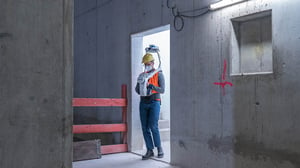A new series exploring all stages of a scan-to-BIM workflow, starting with useful tips for project planning and defining the scope of work with your client.
Your firm has the tools and experience for 3D capture and BIM modeling, so you’re looking to take the natural next step and offer scan-to-BIM services. But a good scan-to-BIM workflow is a complex thing with lots of moving parts, and you don’t have the luxury of figuring it out as you go.
This series of blog posts will help by walking you through the scan-to-BIM process at a high level, breaking down each key stage in detail. In this first post, we’ll start with some tips for the project-planning stage.
Talk to your client about their needs
The most important part of the process is opening lines of communication with your client. Though you should continue communicating throughout the process — to solve problems as they arise — it is crucially important to discuss needs and expectations in the beginning. This way, you can ensure that the project is clearly defined, and everyone is on the same page.
Take the time to ask a lot of questions about what your client wants, as well as why they want it. You might find that your client doesn’t know what they need. This gives you a chance to advise them about the scan-to-BIM process, or which final deliverable will suit them best. You might even be able to save them a little money by advising against a process or deliverable they don’t need.
.jpg?width=1920&name=NavVis-people-7738(1).jpg)
Get important project details
In addition to clarifying your client’s needs and expectations, you’ll also want to get every pertinent detail about the project.
To name a few questions you might ask: How many square meters are you going to scan? Is it occupied? Are you working in a constrained timetable, for instance, in a facility that can only be shut down for a day? What’s the security process like, and will you need a manager’s help to move through different parts of the building?
Many scan-to-BIM providers find it useful to compile all of their pertinent questions into a list that they can send the client ahead of time.
Use standards documents for absolute clarity
When it comes to issues like the project’s level of accuracy (LOA) and level of development (LOD), it can be easy for you and the client to misunderstand each other.
It might seem clear when the client says they want you to get the MEP (mechanical, electrical and plumbling) systems done at a certain accuracy. But there are lots of ways to misread that. Do they want all the MEP at that accuracy? Or should some of them be more accurate? Do they mean they want the data captured at that accuracy, but the model produced at a lower accuracy? What are the acceptable tolerances for the point cloud and the model? And so on.
To clear things up fast, try using specifications documents from a non-profit standards body like the USIBD or BIM Forum in the US. Running through these documents with your client can eliminate misunderstandings, and make for a crystal-clear understanding between you and your client.
.jpg?width=1920&name=NavVis-people-6838(1).jpg)
Define a scope of work (SOW)
This is a document, or collection of documents that lays out the work you’re about to perform in detail. It will include the project description, goals, objectives, accuracy, deliverables, and so on. Be sure to include your LOA and LOD specifications as well. Get the client to sign off.
Next steps...
Now that you’ve carefully defined the project with your client, it’s time to start thinking about planning and executing the scan itself. To learn how, you’ll want to read our next blog post, where we’ll cover tips for hardware selection, using hybrid workflows for best results, and how to plan your scan to ensure smooth work in the field.
Sean Higgins is an independent technology writer, former trade publication editor, and outdoors enthusiast. He believes that clear, buzzword-free writing about 3D technologies is a public service.

